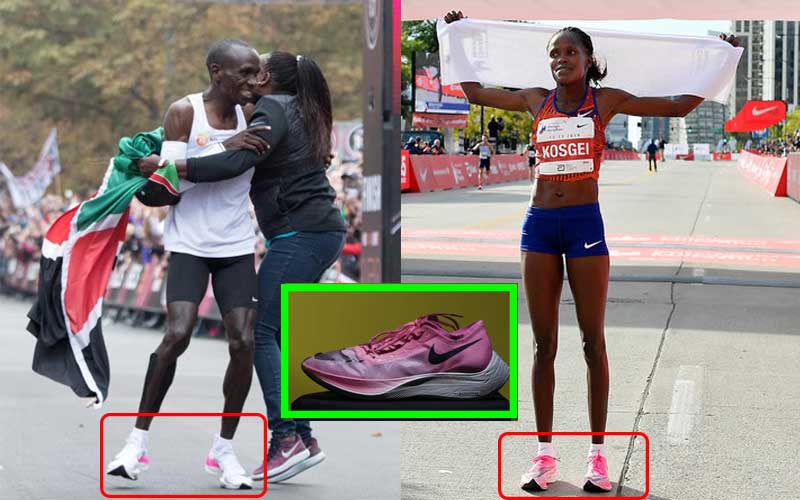
On October 12 2019, Kenyan runner Eliud Kipchoge achieved the feat of running a marathon in under 2 hours.
A day later, fellow Kenyan runner Brigid Kosgei made marathon history by shattering the 16-year record previously held by Britain's Paula Radcliffe. Kosgei ran the Chicago marathon in an astonishing 2:14:04.
What the two elite Kenyan runners had in common during their record-breaking runs were the shoes. Both Kosgei and Kipchoge were wearing versions of Nike’s Vaporfly sneakers.
It didn’t stop there. In the past 13 months, male runners who recorded the five fastest marathon times ever were wearing the sneakers, which were released in 2017.
The success witnessed by wearing the shoe has brought about scrutiny with critics calling for a ban, arguing that the shoe gives runners an unfair advantage.
The shoes are currently under investigation by the International Association of Athletics Federations (IAAF) for possibly boosting the performance of runners. The investigations were launched after some athletes demanded for a probe before the July 2020 Olympic Games in Japan.

Why so fast?
According to experts, the Vaporfly’s success lies in its cutting-edge design.
The Vaporfly’s sole has a carbon fibre mid-section that not only improves stiffness but also stability. The carbon fibre plate also reduces the stress on a runner’s ankle while running.
READ ALSO: Holy water-filled Nike 'Jesus Shoes' costing Sh300,000 sell out in minutes
The Varporfly’s second weapon lies in Pebax foam, the material used in making the sole. Pebax, which Nike calls Zoom X is typically used in aeroplane insulation and is lighter and more resilient compared to materials used in typical running shoes.
The shoe’s mid sole also acts like a spring, saving the energy a runner expends.
Guidelines
According to Nike, the shoes enable runners improve their time by up to 4.2%.

IAAF guidelines on the other hand dictate that a professional athlete’s shoe ‘must not be constructed so as to give athletes any unfair assistance or advantage.’
In a statement to the Wall Street Journal, Nike said that the shoes do not offer any unfair advantage to runners.
“We respect the Word Athletics and the spirit of their rules, and we do not create any running shoes that return more energy that the runner expends,” the statement from Nike read.
Findings of the IAAF investigation are set to be released by the end of January.
Banning swimwear
The Nike Varpofly is not the first to come under scrutiny after numerous world records were shattered.
In 2009, the LZR full-body swimsuit was banned at the World Aquatics Championships for giving swimmers an unfair advantage.
During the competition, 20 new world records were set and even though not all swimmers were wearing the suits, races were becoming manifestly unfair.
American Michael Phelps set world records in seven of his eight events at the 2008 Beijing Olympics wearing the suit.
The new policy dictates that men’s swimsuits may maximally cover the area from the waist to the knee and from the shoulder to the knee for women.
 The Standard Group Plc is a multi-media organization with investments in media
platforms spanning newspaper print
operations, television, radio broadcasting, digital and online services. The
Standard Group is recognized as a
leading multi-media house in Kenya with a key influence in matters of national and
international interest.
The Standard Group Plc is a multi-media organization with investments in media
platforms spanning newspaper print
operations, television, radio broadcasting, digital and online services. The
Standard Group is recognized as a
leading multi-media house in Kenya with a key influence in matters of national and
international interest.
